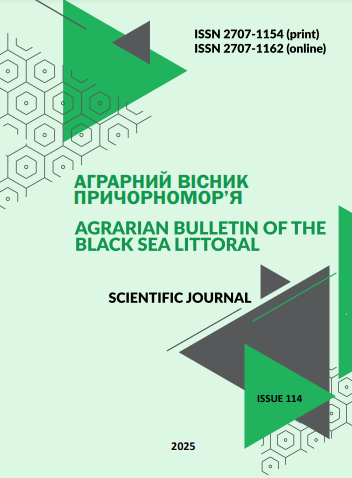SPECIES AND QUANTITATIVE COMPOSITION OF MICROFLORA IN THE TREATMENT OF SUPERFICIAL PYODERMA IN DOGS
DOI:
https://doi.org/10.37000/abbsl.2025.114.04Keywords:
dogs, superficial pyoderma, microflora, treatment, 1,2,4-triazole derivatives.Abstract
The article presents data on the species and quantitative composition of microflora, their sensitivity to antibiotics and the dynamics of microbial contamination during the treatment of superficial pyoderma in dogs.
It was found that Escherichia coli, Staph. epidermidis (57,14 %) and Str. pyogenes (17,86 %), as well as the fungi Malassezia pachydermatis and Candida crusei (21,41 and 14,28 %) predominated in the affected skin areas of sick dogs. The isolated cultures of microorganisms were most sensitive to norfloxacin, fumamag and amoxicillin.
For the topical treatment of dogs with pyoderma, Vetmikoderm and Sanoderm were used in a comparative aspect. During the treatment of sick dogs, we observed a dynamic decrease in the number of microorganisms in the lesions in both groups of animals. However, the level of microbial contamination was significantly lower in the areas of infected skin of animals treated with Vetmikoderm.
References
Rodrigues Hoffmann A. The cutaneous ecosystem: the roles of the skin microbiome in health and its association with inflammatory skin conditions in humans and animals. Vet Dermatol. 2017; 28(1). P. 60.
Guerrero F.F., Cordon C.V. Clinical Immunodermatology. Zaragoza: Servet, 2016. 319 p.
Deodola C., Zanna G. Complex Clinical Cases in Small Animal Dermatology. Zaragoza: Edra, 2022. 180 p.
Darren J. Berger Moriello’s Small Animal Dermatology (Vol. 1). London: Taylor & Francis Group, 2020. 290 p.
Cordeo A.M. Bacterial Skin Infections in Smoll Animals. Zaragoza: Servet, 2019. 127 p.
Kalashnikova Yu. V. Monitorynh piodermii u sobak. Visnyk Luhanskoho NAU. 2014. № 60. S. 56–60.
Baeumer, W., Bizikova, P., Jajcob, M., Linder, K.E. Establishing a canine superficial pyoderma model. J Appl Microbiol. 2017. 122(2). P. 331–337.
Banovic, F., Linder, K., Olivry, T. Clinical, microscopic and microbial characterization of exfoliative superficial pyoderma-associated epidermal collarettes in dogs. Vet Dermatol. 2017. 28(1). P. 107.
Vaughan, D.F., Lemarie, S.L. Comparison of culture and susceptibility results of superficial vs. biopsy specimens in dogs with superficial pyoderma. Vet Dermatol. 2008. 19(2). P. 106–113.
White, S.D., Brown, A.E., Chapman, P.L. et al. Evaluation of aerobic bacteriologic culture of epidermal collarette specimens in dogs with superficial pyoderma. J Am Vet. Med. Assoc. 2005. 226(6). P. 904–908.
Kalashnikova Yu.V., Kononenko I.V. Doslidzhennia dii antyseptychnoi mazi na osnovi nanosribla, midi, yodu. Veterynarna medytsyna Ukrainy. 2011. № 11. S. 17–19.
Borysevych V.B., Sukhonos V.P., Kalashnikova Yu.V. Antymikrobni vlastyvosti nanoakvakhelativ metaliv. Naukovyi visnyk NUBiP. 2009. № 140. S. 209–214.
Kalashnikova Yu.V. Boiko O.V. Protymikrobna aktyvnist nanoakvakhelativ sribla ta midi. Veterynarna biotekhnolohiia. 2010. № 16. S. 85–88.
Kalashnikova Yu.V., Sukhonos V.P. Vydovyi sklad ta stiikist do antybiotykiv mikroflory shkiry zdorovykh i khvorykh na piodermiiu sobak. Naukovyi visnyk veterynarnoi medytsyny. 2014. № 13. S. 102–104.
Kalashnikova Yu.V. Klinichne doslidzhennia dii mazi nanosept na osnovi nanoakvakhelativ Ag, Cu ta J pry piodermii v sobak. Veterynarna medytsyna Ukrainy. 2014. № 9 (223). S. 30–31.
Borio, S., Colombo, S., La Rosa, G. et al. Effectiveness of a combined (4 % chlorhexidine digluconate shampoo and solution) protocol in MRS and non-MRS canine superficial pyoderma: a randomized, blinded, antibiotic-controlled study. Vet. Dermatol. 2015. 26(5). P. 339–372.
Jeffers, J.G. Topical therapy for drug-resistant pyoderma in small animals. Vet. Clin. Small Anim. Pract. 2013. 43(1). P. 41–50.
Loeffler, A., Cobb, M.A., Bond, R. Comparison of a chlorhexidine and a benzoyl peroxide shampoo as sole treatment in canine superficial pyoderma. Vet. Rec. 2011. 169(10). P. 249–249.
Murayama, N., Terada, Y., Okuaki, M., Nagata, M. Dose assessment of 2% chlorhexidine acetate for canine superficial pyoderma. Vet. Dermatol. 2011. 22(5). P. 449–453.
Mueller, R.S., Bergvall, K., Bensignor, E., Bond, R. A review of topical therapy for skin infections with bacteria and yeast. Vet. Dermatol. 2012. 23(4). P. 330–341.
Loeffler, A., Lloyd, D.H. What has changed in canine pyoderma? A narrative review. Vet. J. 2018. Vol. 235. P. 73–82.
Stefanetti, V., Bietta, A., Pascucci, L., et al. Investigation of the antibiotic resistance and biofilm formation of Staphylococcus pseudintermedius strains isolated from canine pyoderma. Veterinaria italiana. 2017. 53(4). P. 289–296.
Kyrychko B., Klymas I., Parchenko V. Osoblyvosti syntezu i vyznachennia protymikrobnoi aktyvnosti 4-((5-(detsyltio)-4-metyl-4N-1,2,4-tryazol-3-il)morfolinu. Ahrarnyi visnyk Prychornomor`ia. 2024. № 110. S. 143-148.
Martynyshyn V.P. Farmako-toksykolohichna otsinka ta likuvalna efektyvnist preparatu na osnovi S-pokhidnoi 1,2,4-tryazolu za dermatomikoziv u sobak: dys. d-ra filosofii: 211 Vet. medytsyna. Lviv, 2021. 181 s.
Downloads
Published
How to Cite
Issue
Section
License

This work is licensed under a Creative Commons Attribution-NonCommercial 4.0 International License.


